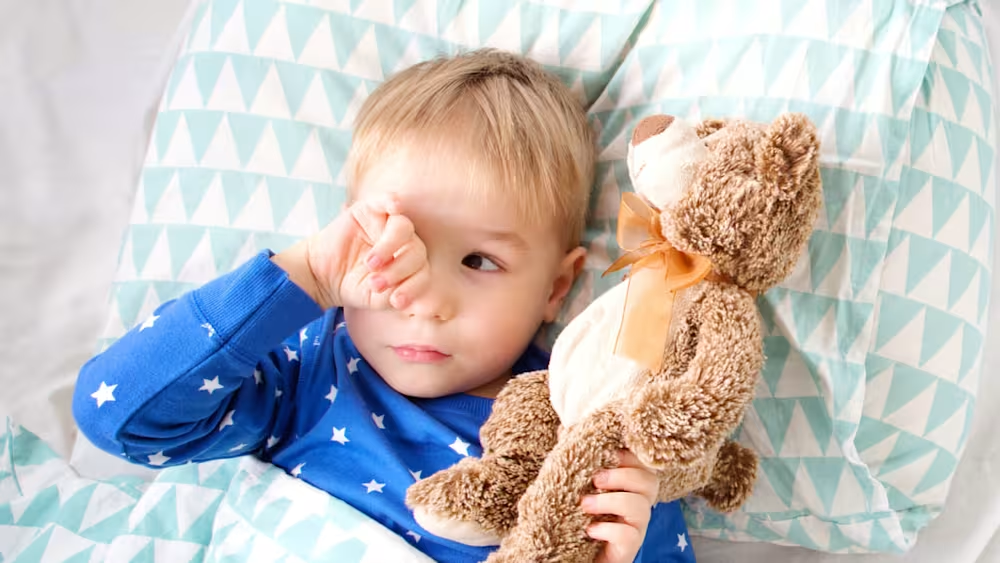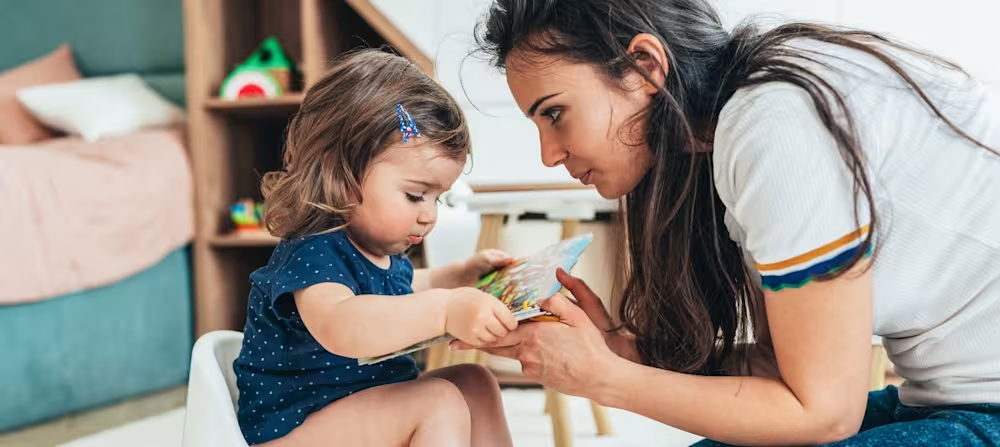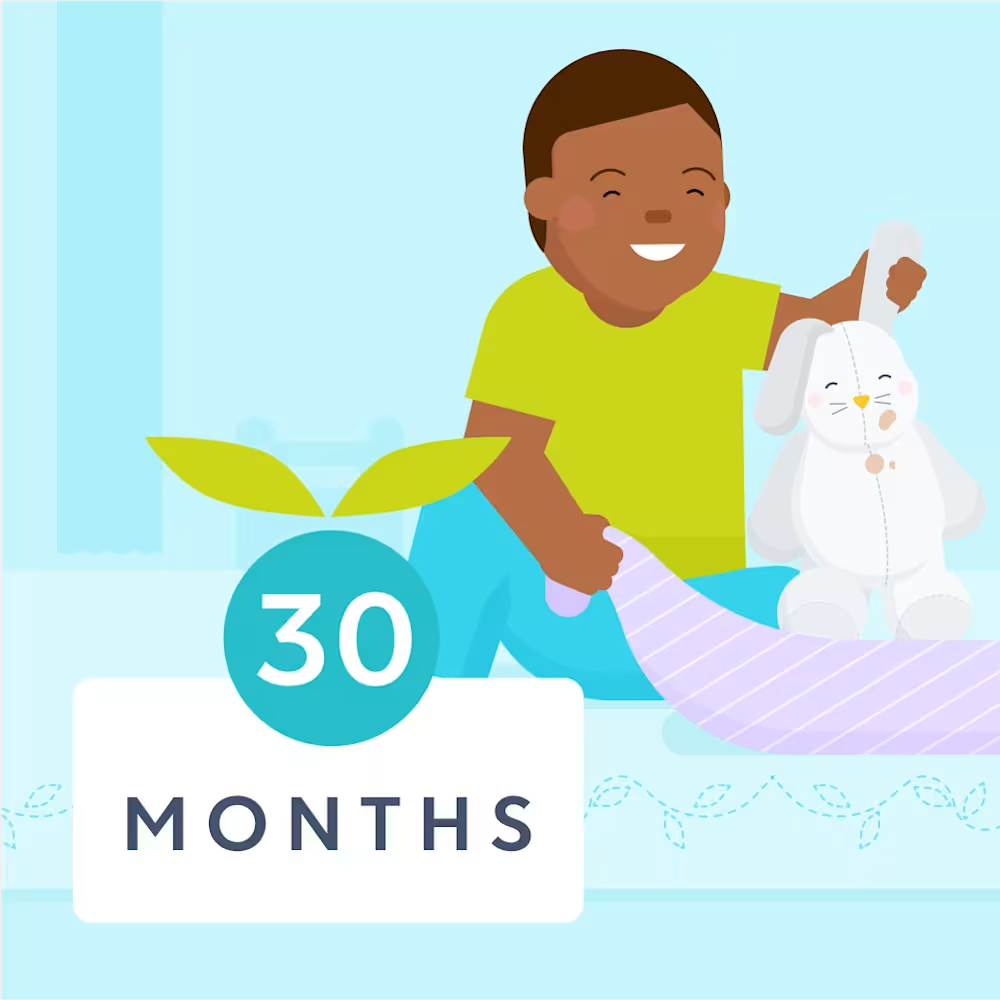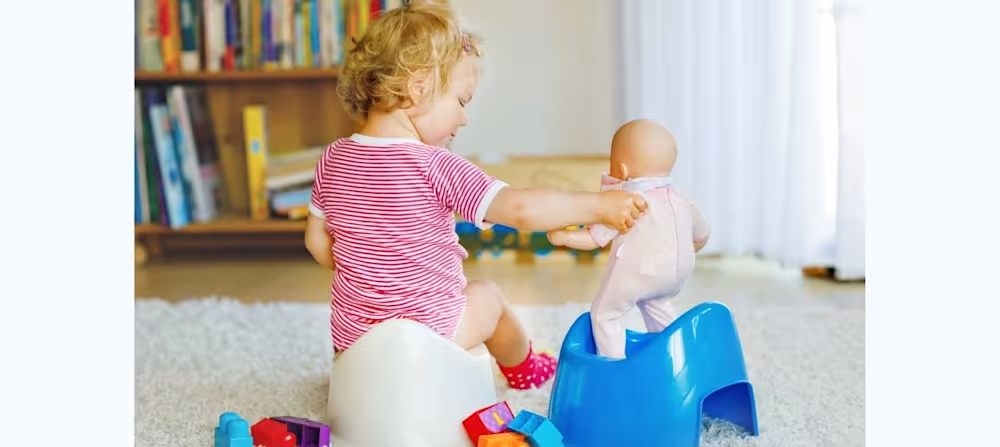30 month old toddler milestones: Development, growth, speech, language, and more
Updated Dec 29, 2025
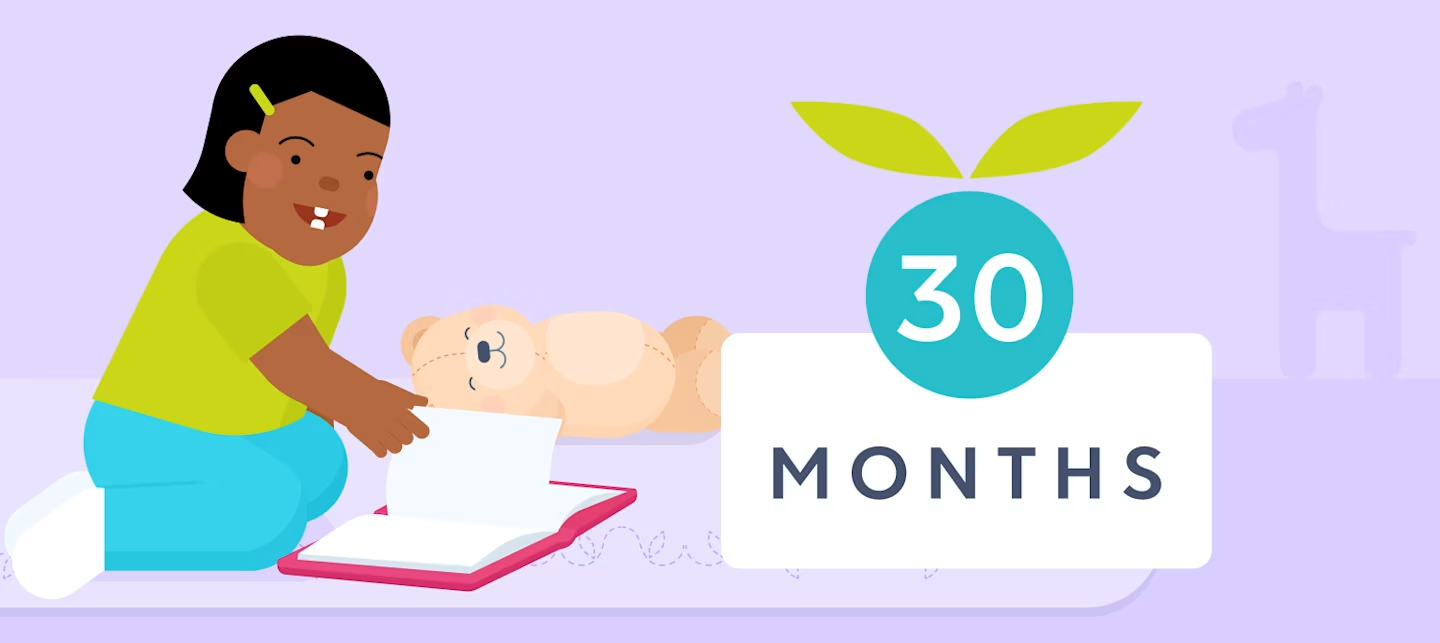
At 30 months (or 2.5 years), your toddler is likely growing more independent — and keeping you on your toes in the process. From physical milestones like climbing and jumping to bursts of speech, language, and imaginative play, this stage is packed with exciting changes. In this guide, we’ll walk through key 30 month old developmental milestones in physical, social, emotional, and language growth. You’ll also find a simple checklist, signs to watch for, and tips to support your toddler’s development.
Table of Contents
30 month old toddler milestones at a glance
According to the CDC, developmental milestones are things most children (75% or more) can do by a certain age []. Wondering what’s typical for a toddler at 30 months? Here’s a quick look at three key areas of development:
Development
Around this age, toddlers often show big leaps in communication, imaginative play, and hand-eye coordination. Common 30 month developmental milestones include using short sentences, following two-step directions, and beginning to play cooperatively [].
Sleep
We typically recommend aiming for about 12 hours of sleep (or more) in a 24-hour period at this age, including naps. Most still need. However, as your kiddo creeps closer to 3, they’ll be able to comfortably stay awake for longer periods, This can lead to a resurgence of nap resistance (along with short or skipped naps). Who wants to nap when you can stay up and play?! Aiming for a set schedule that allows for about 6 hours of wake time before the nap can make it easier for your child to fall asleep.
Feeding
Most 30 month olds eat three meals and 2 - 3 snacks each day. Their appetite may vary, but they generally need about 1,000 - 1,400 calories daily to support healthy growth [].
It’s normal for toddlers to make their very clear at this age. This type of picky eating behavior is normal! Chances are, it’ll lessen over time. Continue offering a variety of foods and serve new ones alongside already accepted favorites (you know, like mac and cheese).
30 month development milestones
Here’s a quick look at common developmental milestones for a 30 month old toddler. Remember: Every child develops at their own pace. This checklist is a general guide, not a scorecard.
Physical development
Toddlers are on the move at 30 months and gaining new physical skills quickly. While every child develops at a different rate, here are some typical physical milestones for a toddler at this age:
Gross motor skills: Your toddler may be running with more control, climbing on furniture or playground equipment, jumping with both feet, and starting to kick a ball []. These 30 month gross motor milestones reflect growing strength, balance, and coordination.
Fine motor skills: Around this age, toddlers often turn pages in a book one at a time, stack six or more blocks, hold crayons or markers with more control, and begin using utensils with less help []. These 30 month fine motor milestones support daily routines like dressing, eating, and playing.
Hand-eye coordination: You may notice improvements in tasks like catching a large ball, fitting shapes into puzzles, or threading large beads []. These activities support brain development and help toddlers learn through hands-on play.
Facial expressions and body language: At 2.5 years old, toddlers may use more expressive gestures and dynamic facial expressions to show emotions or imitate others, and react to emotive facial expressions []. These nonverbal skills are key to emotional and social development.
Toileting: Some toddlers show interest in toilet training at this stage. Signs of readiness might include staying dry for longer stretches, asking to use the toilet, or showing discomfort with dirty diapers [6]. Full may still be months away — and that’s perfectly normal too.
Social development
At 30 months old, your toddler is developing a stronger sense of self, along with big feelings and even bigger opinions. These milestones reflect growing emotional awareness, social development, and early behavior regulation.
Emotional development
Toddlers at this age often express a wide range of emotions, from joy and excitement to frustration or fear. Tantrums are still common, as emotional regulation is just beginning to develop []. You might also notice more use of facial expressions, tone of voice, and body language to communicate their feelings.
Behavioral development
Expect plenty of limit-testing — it’s how toddlers learn boundaries and assert independence. Your child may also begin to follow simple rules, imitate grown-up behaviors, and show early signs of empathy, like offering a toy to a friend who’s upset [].
Social interaction: Many toddlers begin engaging in parallel play and may experiment with cooperative play, especially with familiar children or siblings. Skills like sharing and turn-taking are still emerging and often need guidance and modeling from caregivers [].
Sense of independence: You’ll likely see more “I do it!” moments. Whether it’s choosing a snack, getting dressed, or climbing into their car seat, toddlers want more control — and that’s a healthy part of this stage of development [].
Language development
Language development often takes a big leap around 30 months. While there’s a wide range of what’s typical, many toddlers begin to express themselves more clearly and confidently. Here are some common 30 month old speech and communication milestones:
Vocabulary growth: At this stage, toddlers may use 50 - 100 (or more!) words and continue adding new ones every day []. You might hear them label familiar people, objects, or routines, or repeat phrases from books and conversations.
Combining words: This is a major 30 month old speech milestone. Many toddlers begin putting two to three words together to form simple phrases like “want juice” or “go outside now. []” These early sentences help them share more of what they think, feel, and need.
Understanding language: Receptive language often comes before expressive language. Your toddler likely understands simple questions, follows two-step directions (like “Get your shoes and bring them here”), and recognizes common names and objects [].
Pronunciation quirks: At 2.5 years old, it’s normal if your toddler’s speech is sometimes hard to understand [8]. As long as they’re trying to communicate and you can usually figure out what they mean, articulation will continue to develop.
Imitating and storytelling: Many toddlers love to mimic words and phrases they hear and may begin “telling stories” during pretend play. Books, music, and back-and-forth chats are great ways to support 30 month old language development during this stage [].
If you’re concerned about possible developmental delays or your toddler isn’t using words to communicate by this age, check in with your pediatrician or speech-language pathologist. Early support can make a big difference.
30 months development milestones checklist
Cognitive and language:
Uses 50 - 100+ words
Combines 2 - 3 words into short sentences
Understands simple directions (“Get your shoes”)
Names familiar objects and people
Pretends during play (e.g., feeding a doll or stuffed animal)
Social and emotional:
Shows big emotions (and may need help managing them)
Imitates adults and older children
Starts engaging in parallel or cooperative play
Expresses affection with hugs or kisses
Shows independence (“I do it!” moments)
Physical (gross and fine motor):
Runs, climbs, jumps with both feet
Begins to throw and kick a ball
Stacks at least six blocks
Turns book pages one at a time
Starts using a spoon or fork with less help
Self-care and daily routines:
May show interest in toilet training
Helps with dressing (e.g., pulls pants up or down)
Begins brushing teeth with assistance
Can follow simple routines (e.g., cleaning up toys)
Don’t stress if your toddler isn’t hitting every milestone right now. Development isn’t always linear. If you have questions or concerns, your pediatrician can help track progress and offer guidance that fits your child’s unique needs.
What are 30 month development red flags?
Every child develops at their own pace, and it’s normal for milestones to happen at slightly different times. Still, there are some signs that may signal the need for extra support. Check in with your child’s healthcare provider if your 30 month old []:
Isn’t walking steadily on their own
Doesn’t copy actions or words from others
Doesn’t follow simple directions (like “come here” or “give me the toy”)
Uses fewer than 15 words or doesn’t seem to be learning new ones
Doesn’t point to objects to share interest or get your attention
Doesn’t notice or react when familiar people leave or return
Doesn’t know how to use everyday objects (like a spoon, cup, or brush)
Has lost skills they once had
If you have any other concerns about your toddler’s development, it’s always best to bring them up with your pediatrician. Early support can make a big difference.
3 development tips for 30 month olds
Tip | Why it helps | How to put it into practice |
|---|---|---|
Read together every day | Shared reading boosts language skills, attention, and connection. Repetition helps toddlers lock in new words and ideas. | Label pictures, ask simple questions, and follow their interests — even if it’s the same book over and over. |
Invite them to help with small tasks | Little “jobs” build independence, fine motor skills, and confidence. Toddlers love feeling included in real work. | Offer tiny tasks like tossing laundry in a basket or wiping a spill. Keep it slow, patient, and collaborative. |
Narrate your day | Hearing language in context supports vocabulary, sequencing, and early problem-solving, while helping link words to actions. | Describe what you’re doing in simple phrases that are natural and conversational (“Shoes on, then outside”). |
Find more details below:
Support your toddler’s growth with these simple, everyday activities. Each one encourages development across physical, emotional, social, and language domains while keeping things playful and fun.
Tip #1: Read together every day
Reading books together supports your 30 month old’s language development and strengthens your connection []. Ask questions, label pictures, and follow your toddler’s interests — even if that means reading the same book five times (in a row, forever). Repetition helps new words and ideas stick.
Tip #2: Encourage helping with daily tasks
Inviting toddlers to “help” with small chores can build confidence and hand-eye coordination. Whether they’re putting laundry in a basket or helping wipe up a spill, these simple tasks support fine motor skills and independence []. However, sometimes this means a small task becomes a long, drawn-out endeavor. For best results, ensure you have the time (and patience!) to collaborate with your 2 year old.
Tip #3: Narrate your day
Talk through daily routines in real time (“Now we’re brushing your teeth — up, down!”). This kind of language modeling supports 30 month old speech milestones and helps toddlers understand sequencing, cause and effect, and vocabulary through context [].
Activities for a toddler at 30 months
1. Play music and dance
Music activities are great for brain development and body awareness []. Sing songs, clap to the beat, or dance together. Encourage your toddler to use toy instruments or their own body movements. It’s a fun way to support rhythm, memory, and coordination.
2. Offer open-ended toys
Open-ended toys — like blocks, dolls, pretend food, or art supplies — promote creativity, problem-solving, and fine motor skills. These kinds of toys invite exploration and learning through play. Rotate them regularly to keep your child engaged [].
3. Take your toddler for a walk (and let them lead!)
Outdoor walks are great for gross motor development, offering chances to practice balance, coordination, and spatial awareness [2]. Let your toddler set the pace and choose the path (within safe boundaries). This builds decision-making skills, independence, and curiosity.
Caring for a sick 30 month old
Milestone progress can be temporarily disrupted when your little one is under the weather. Illnesses, like colds or ear infections, are common at this stage as their immune system continues to develop. You may find you need to adjust routines and provide extra comfort (especially around sleep times!) when your toddler is sick. Here are some tips for caring for your sick little one:
Keep them hydrated: Fluids are especially important when your toddler isn’t feeling well. If meals are less appealing, focus on offering frequent small sips of water, milk, or other age-appropriate drinks.
Relieve congestion: A blocked nose can make it tough for toddlers to eat and sleep. Using a cool-mist humidifier, saline drops, and gentle suction can help clear nasal passages, especially before naps and bedtime.
Watch fevers closely: Call your pediatrician if your toddler’s fever lasts more than 24 hours or repeatedly goes over 104°F (40°C) []. If their doctor recommends it, children’s Tylenol or Motrin may be used. Avoid cough and cold medicines, as they’re not safe for young children.
Adjust sleep routines: Illness often means more night waking or changes in nap length. Allow your toddler the extra rest they need now and return to regular routines once they’re better.
Provide comfort: Some toddlers want extra closeness when sick, while others may prefer more space. Follow their lead to help them feel secure. Remember, caring for a sick child can be tiring — lean on your support system when possible.
When to seek help
If your child has a fever for more than 24 hours or it reaches above 104°F (40°C), call their doctor right away. These can be signs of a more serious infection or illness and it's best to rule out anything that needs medical attention.
In general, if something feels off or you’re worried about how your child looks or acts, it’s safest to check in with their doctor. And if you already talked to them but symptoms appear worse, that’s a good time to check back in too.
Takeaway
Development is a journey, not a race. Milestones like walking, talking, and social-emotional skills unfold at different times for every child.
Keep an eye on physical and language growth. Use our 30 month developmental checklist to track key milestones and notice areas where your toddler is learning and growing.
Support learning through play. Activities like reading, outdoor walks, music, and open-ended toys are powerful ways to build skills while bonding.
Know when to check in with your family doctor. If you have concerns about speech, motor skills, or behavior, your pediatrician or a developmental specialist can help you explore next steps.
Your presence matters most. Whether navigating tantrums or celebrating new words, your calm connection lays the foundation for lifelong learning.
30 month old development milestones FAQ
Share article:
Note: The content on this site is for informational purposes only and should not replace medical advice from your doctor, pediatrician, or medical professional. If you have questions or concerns, you should contact a medical professional.
12 Sources
Table of Contents
Share article:
